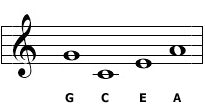How to Tune a Ukulele
Like all stringed instruments, ukuleles need tuning before you play them. There are usually two questions that people ask about how to tune a ukulele; what notes should I tune the strings to? and what method should I use to tune my ukulele? So here are the answers!Standard Ukulele Tuning
Soprano, concert and tenor ukuleles are most often tuned to G-C-E-A or ‘C Tuning’. Unlike the guitar, the strings on soprano, concert and tenor ukuleles are not tuned from low to high. Instead, the G is tuned above the C and E strings. This is called re-entrant tuning. It serves to keep the notes of the chords in the same range. This is what contributes to the ukuleles distinctive sound. Another way of demonstrating this is on a musical staff:
Unlike the guitar, the strings on soprano, concert and tenor ukuleles are not tuned from low to high. Instead, the G is tuned above the C and E strings. This is called re-entrant tuning. It serves to keep the notes of the chords in the same range. This is what contributes to the ukuleles distinctive sound. Another way of demonstrating this is on a musical staff:  Even if you don’t read music, you will see that the G is higher in pitch than the C and E. Soprano ukuleles are also sometimes tuned to A-D-F#-B, known as ‘D Tuning’. A tone higher than standard tuning. Some advanced players prefer this tuning as the tighter string tension gives a brighter, springier sound.
Even if you don’t read music, you will see that the G is higher in pitch than the C and E. Soprano ukuleles are also sometimes tuned to A-D-F#-B, known as ‘D Tuning’. A tone higher than standard tuning. Some advanced players prefer this tuning as the tighter string tension gives a brighter, springier sound.
Tenor and Baritone Ukuleles
The tenor ukulele is often tuned in re-entrant C Tuning. However, some people prefer to use linear tuning. They tune the G string an octave lower to below the C and E strings. Baritone Ukuleles, on the other hand, are more commonly tuned in linear tuning as standard. Tuned to the same notes as the top strings of a guitar- D-G-B-E.

What’s the best way to tune a ukulele?
There are a couple of different methods that can be used to tune a ukulele. Which one you use is personal preference or it may depend on what equipment you have to hand.Tuning Using a Digital Tuner
A digital tuner is a great accessory to have for any stringed instrument. Many designs are extremely compact and clip onto the headstock for tuning. A digital tuner will detect the note being played and show how many cents (a measurement of pitch) it is away from dead centre.
Chromatic tuners like this 3rd Avenue tuner will tune every note in the scale, useful if you play more than one string instrument or use alternative tunings, while other designs like this Ukulele Tuner are intended for a specific instrument, helping you get to those pitches as fast as possible. The advantage of using a digital tuner over tuning by ear is that this method is extremely fast and accurate.
Tuning by Ear
You can use another instrument, such as a piano as a reference to tune your ukulele or take a reference from specially designed ukulele pitch pipes, which use a reed to produce a pitch when you blow air into them.
To tune a ukulele this way, play the note on the reference instrument or pitch pipe and play the string on the ukulele. Slowly turn the tuning peg counter clockwise until the pitches match. If the string is too high, it’s easier to lower the pitch to below the note and bring it up to pitch. As the two pitches get closer, you will begin to hear a warbling sound (known as beating) and when the two are completely in tune with one another, this will disappear. Tuning by ear is a great way to improve your musical ear and as you practice you will find that you are able to get the instrument more precisely in tune and in a quicker time.
Don’t have a ukulele yet? Check out our full range here.




















